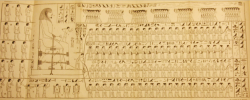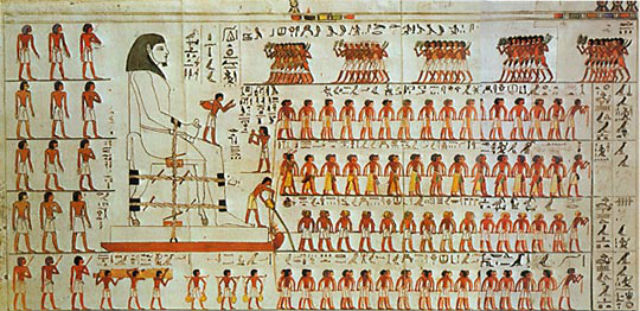It looks like you're using an Ad Blocker.
Please white-list or disable AboveTopSecret.com in your ad-blocking tool.
Thank you.
Some features of ATS will be disabled while you continue to use an ad-blocker.
share:
A sled...
can anyone explain Baalbeck Lebanon
several stones 64 ft long 16ft by 16ft wide and weigh over 1200 tones each quarried from a mountain half a mile away
moved from the quarry site and lifted 12ft to be laid end to end to form a platform perfectly flat that happens to be 5.5million square ft in diameter
can anyone explain Baalbeck Lebanon
several stones 64 ft long 16ft by 16ft wide and weigh over 1200 tones each quarried from a mountain half a mile away
moved from the quarry site and lifted 12ft to be laid end to end to form a platform perfectly flat that happens to be 5.5million square ft in diameter
a reply to: daaskapital
YOU LIE!


you know i had to...it was bound to happen anyway, lol
on the real though, this is pretty cool....if true, it's a real testament to how smart, and inventive people were back then..
YOU LIE!


you know i had to...it was bound to happen anyway, lol
on the real though, this is pretty cool....if true, it's a real testament to how smart, and inventive people were back then..
originally posted by: daaskapital
It all comes down to friction. See, the ancient Egyptians would transport their rocky cargo across the desert sands, from quarry to monument site with large sleds. ...
Interesting stuff...
everyone seems to think the workers drug the sleds with the cargo over 'sand'... wet sand
a look at the picture shows rows of laborers standing on black lines, I say that rows of boards were laid down on the sand and water (even sweat and urine) was used to lubricate the boards used as a path for the skid to ride over..
the guy pouring liquid was wetting not the sand.. but rinsing off the sand still on the greased boards laid upon the sand
next of all... there was no mention of how they managed to lift that Seated Pharoh on to the giant sled in the first place
edit on
st31139893933201152014 by St Udio because: (no reason given)
edit on st31139893952301182014 by St Udio because: (no reason
given)
Lebanese cedar is the hardwood that was available.....
I want to know how they lifted the 20 tonners?.....if they lifted them???
with Baalbek the trithalons were slid into place...no lifting involved....according to the experts...
I want to know how they lifted the 20 tonners?.....if they lifted them???
with Baalbek the trithalons were slid into place...no lifting involved....according to the experts...
a reply to: daaskapital
I don't think the issue was ever going from point A to Point B it has always been stacking the stones being perfect fit within thousandths of an inch, and not collapsing on itself with the rooms and hall ways on the inside while stacking. They haven't figured that out, and they haven't figured out how they made the crystal skulls either, we don't even have the technology today to make one of those.
I don't think the issue was ever going from point A to Point B it has always been stacking the stones being perfect fit within thousandths of an inch, and not collapsing on itself with the rooms and hall ways on the inside while stacking. They haven't figured that out, and they haven't figured out how they made the crystal skulls either, we don't even have the technology today to make one of those.
I'm not so sure why everyone is so hostile towards this type of research.
Physicists did research on this, came up with some solid maths theories, but everyone is upset? It may not explain everything, but it seems like whenever the science field doesn't touch something everyone complains they don't touch it ... and whenever they do, they get yelled at for not ummm ... building the great pyramid immediately?
This type of work should be encouraged.
Regarding the Crystal Skulls, its worth looking into a little deeper. At least several of them are fraudulent!
Physicists did research on this, came up with some solid maths theories, but everyone is upset? It may not explain everything, but it seems like whenever the science field doesn't touch something everyone complains they don't touch it ... and whenever they do, they get yelled at for not ummm ... building the great pyramid immediately?
This type of work should be encouraged.
Regarding the Crystal Skulls, its worth looking into a little deeper. At least several of them are fraudulent!
a reply to: daaskapital
But how did they get those blocks into place and actually up there, can't do that with water.
But how did they get those blocks into place and actually up there, can't do that with water.
yes, no one ever thought of greasing the skids before
lol...
brilliant!
lol...
brilliant!
originally posted by: daaskapital
The question of just how an ancient civilisation — without the help of modern technology — moved the two-tonne stones that made up their famed pyramids has long plagued Egyptologists and mechanical engineers alike. But now, a team from the University of Amsterdam believes they have figured it out, even though the solution was staring them in the face all along.
Scientists have allegedly discovered the way in which the Ancient Egyptians transported their large cargo. It is said that the Egyptians would use sleds, and water, to transport the cargo from one place to another.
And how does that explain 2.3 million rocks being moved through sand in great distance, carved, raised and put in place in 23 years? The egyptologists' calculations suggest the workforce could have sustained a rate of 3 stones/minute, which means 180 block per hours in order to fit the massive number of 2.3 million in 20-23 years time of construction. So to put it roughly into an equation:
No matter how many workers were used or in what configuration, 1.1 blocks would have to be put in place every 2 minutes, ten hours a day, 365 days a year for twenty years to complete the Great Pyramid within this time frame. To use the same equation, but instead assuming the time of completion to be one hundred years instead of twenty, it would require 1.1 blocks to be set every ten minutes.
This equation, however, does not include the time and labor required to design, plan, survey, and level the 13 acre site the Great Pyramid sits on. Nor does it include the construction time for the two other main pyramids on the site, the Sphinx, the temples, networks of causeways, several square miles of paving stones, the leveling of the entire Giza plateau, the 35 boat pits carved out of solid bedrock, or several other highly laborious features. When considering the time it would have taken to build the Great Pyramid alone, it is worth noting that the entire Giza plateau was constructed over the reign of five pharaohs in less than a hundred years. This feat is even more impressive, given that beginning with king Djoser who ruled from 2687-2667 BC, three other massive pyramids were built - the Step pyramid of Saqqara (believed to be the first Egyptian pyramid), the Bent Pyramid, and the Red Pyramid. Also during this time period (between 2686 and 2498 BC) the Wadi Al-Garawi dam which used an estimated 100,000 cubic metres of rock and rubble was built. Beginning with Saqqara, Egyptologist Barbara Mertz estimates nearly 700 pyramids were constructed in Egypt during a roughly 500 year period.
Just saying...
edit on 1-5-2014 by Telos because: (no reason given)
a reply to: Yusomad
Wouldn't it be very likely that they used the same wood which was used to build their ships. They had many trade route including mention of silk trade.
Don't take this the wrong way but reading your posts it seems as if you really want the building of the pyramids to remain a mystery and seem extremely dismissive of any common sense solution.
Can I ask do you not want answers to the building of the pyrimids or would common sense answers that do not require a supernatural force or extraterrestrial help bother you in some way?
Wouldn't it be very likely that they used the same wood which was used to build their ships. They had many trade route including mention of silk trade.
Don't take this the wrong way but reading your posts it seems as if you really want the building of the pyramids to remain a mystery and seem extremely dismissive of any common sense solution.
Can I ask do you not want answers to the building of the pyrimids or would common sense answers that do not require a supernatural force or extraterrestrial help bother you in some way?
edit on 1-5-2014 by Grimpachi because: (no reason given)
So how did Edward Leedskalnin do coral castle? with wet sand.
I think the ancient Egyptians came across the pyramids and then squatted there and try to replicate them in some smaller versions surrounding it and failed at doing so.
I don't think ancient Egyptians are the original builders of these great things.
I think the ancient Egyptians came across the pyramids and then squatted there and try to replicate them in some smaller versions surrounding it and failed at doing so.
I don't think ancient Egyptians are the original builders of these great things.
edit on 1-5-2014 by Fisherr because: (no reason
given)
I'm not one of the faithful when it comes to the High Church of Science, so if these great-and-mighty priests of unproven theory want me to buy the
dogma, they can start coughing up some actual proof.
Seeing is believing. If they can show some videos of people moving similarly-sized stones at the necessary rate using this method, then I'll buy it.
Until then, it's a giant wash.
Seeing is believing. If they can show some videos of people moving similarly-sized stones at the necessary rate using this method, then I'll buy it.
Until then, it's a giant wash.
What makes you think the sled isn't strong enough? The artwork shows a sled, and I don't see why anyone would argue against that. Just because you don't know what kinds of wood they had available doesn't mean they can't make a sled like that shown in the drawing.
originally posted by: Yusomad
How much would reduced friction help you if the sled is not strong enough (hence the strong wood remark) to support whatever you put on it? If the sled becomes crushed because palm trees are not "real" wood, how is reduced friction going to get you anywhere?
It's an interesting drawing and yes it does look like the man is pouring something in front of the sled, and there are more guys below him ready to hand him more containers to pour. Looks like lots of people pulling it too.
Wally Wallington says he knows how the pyramids were built and can erect a facsimile of Stonehenge. He can move huge stones around all by himself, using sticks and stones. He may be more clever than some scientists when it comes to this stuff.
How Stonehenge Was Built?" Wally Wallington Can Move Anything!
edit on 1-5-2014 by Arbitrageur because: clarification
a reply to: daaskapital
Here is a Larger Version of the Image if you click:

You will see 8 lines of men on 4 ropes pulling the front. The art isn't in perspective. They drew everything from the side, but we are looking down from the top sort of. I mean that the guys on the top right are no higher in elevation than those on the bottom.
I do think the guy could be pouring something and there maybe other guys carrying more, but he could be holding a steering device of some kind as well, and the other guys could simply be carrying water for the workers to drink. They don't show a lot of guys carrying water, so I would think they are not wasting it on the desert floor.
The taller guys in the back seem to be giving symbol orders. Notice their are 3 in a line. In 3 of those lines the guy in front has bent elbow, but in the other line the guy in the middle has bent elbow. I think this is a way of tightening or losening the slack in the ropes.
The guys with rods could be "slave masters," but I am more inclined to think that this is a group effort and the bigger guys are more important or maybe just bigger.. Everyone is wearing the same "skirt." The rods could be another signaling device or maybe some tool for lining up?
there are guys at the bottom carrying an odd shaped "log?" or structure thing?? This seems to have a specific purpose, but I wonder what? Maybe some sort of device involved in separating the sled from the statue?
By the way I think the scientists are right about how the Egyptians built things back then, but where we differ is that I never ASSUME the Egyptians had anything to do with the great pyramid. Maybe after the fall of "babylon" or "Atlantis" survivors hung around as gods and started civilizations as a tool of not having to do any of the work. a mutual deal with tribal humans... Then you'd have egyptians starting out with a full society building up buildings around the gods buildings. After the masters leave society starts to fall off....
Here is a Larger Version of the Image if you click:

You will see 8 lines of men on 4 ropes pulling the front. The art isn't in perspective. They drew everything from the side, but we are looking down from the top sort of. I mean that the guys on the top right are no higher in elevation than those on the bottom.
I do think the guy could be pouring something and there maybe other guys carrying more, but he could be holding a steering device of some kind as well, and the other guys could simply be carrying water for the workers to drink. They don't show a lot of guys carrying water, so I would think they are not wasting it on the desert floor.
The taller guys in the back seem to be giving symbol orders. Notice their are 3 in a line. In 3 of those lines the guy in front has bent elbow, but in the other line the guy in the middle has bent elbow. I think this is a way of tightening or losening the slack in the ropes.
The guys with rods could be "slave masters," but I am more inclined to think that this is a group effort and the bigger guys are more important or maybe just bigger.. Everyone is wearing the same "skirt." The rods could be another signaling device or maybe some tool for lining up?
there are guys at the bottom carrying an odd shaped "log?" or structure thing?? This seems to have a specific purpose, but I wonder what? Maybe some sort of device involved in separating the sled from the statue?
By the way I think the scientists are right about how the Egyptians built things back then, but where we differ is that I never ASSUME the Egyptians had anything to do with the great pyramid. Maybe after the fall of "babylon" or "Atlantis" survivors hung around as gods and started civilizations as a tool of not having to do any of the work. a mutual deal with tribal humans... Then you'd have egyptians starting out with a full society building up buildings around the gods buildings. After the masters leave society starts to fall off....
edit on 1-5-2014 by KnightLight because: (no
reason given)
edit on 1-5-2014 by KnightLight because: (no reason given)
a reply to: daaskapital
Interesting. F&S
a reply to: ignorant_ape
RE: Water source for wetting sand.
When did the area's climate change? Are we certain desertification occurred before the pyramids were built?
Interesting. F&S
a reply to: ignorant_ape
RE: Water source for wetting sand.
When did the area's climate change? Are we certain desertification occurred before the pyramids were built?
edit on 1/5/14 by soficrow because: link
a reply to: daaskapital
Why don't they try this with real weight on a real sled in a real desert? Seems simple enough to do if they really belive it was done this way.
Why don't they try this with real weight on a real sled in a real desert? Seems simple enough to do if they really belive it was done this way.
It is an interesting theory, but would'nt it be easier just to decipher the hieroglyphics?
This is my take on it, firstly I have no idea what the hieros mean, but I seem to recall that the Egyptians were almost obsessive with counting things, making logs of what they had etc.
To me this image looks like a formula about what it takes in "Power" to move a carved object.
So the object is 4 cubits high, 3 cubits long and fits on a 5 cubit sled. wild guess...
Therefore it takes 4 rows of 16 men X 2 (they seem to be dual rows), to pull a carved, (we are assuming stone, but it may be wood? or granite, or sandstone, or limestone) Pharaoh 1/4 of a Roman mile, or somesuch.
It also takes 5 rows of 7 stonemason slaves/tradesman to carve the statue..(top row, men holding tools)
It takes 3 slaves carrying water for the pullers.( bottom front of statue.)
5 Rows of 3 overseers/soldiers to keep order. (rear statue top to bottom).
And a few extra slaves carrying spare sled wood, just in case.
Does this seem a reasonable theory?
Perhaps there is a genuine accurate translation of this image..of course there must be.....so what does it say?
This is my take on it, firstly I have no idea what the hieros mean, but I seem to recall that the Egyptians were almost obsessive with counting things, making logs of what they had etc.
To me this image looks like a formula about what it takes in "Power" to move a carved object.
So the object is 4 cubits high, 3 cubits long and fits on a 5 cubit sled. wild guess...
Therefore it takes 4 rows of 16 men X 2 (they seem to be dual rows), to pull a carved, (we are assuming stone, but it may be wood? or granite, or sandstone, or limestone) Pharaoh 1/4 of a Roman mile, or somesuch.
It also takes 5 rows of 7 stonemason slaves/tradesman to carve the statue..(top row, men holding tools)
It takes 3 slaves carrying water for the pullers.( bottom front of statue.)
5 Rows of 3 overseers/soldiers to keep order. (rear statue top to bottom).
And a few extra slaves carrying spare sled wood, just in case.
Does this seem a reasonable theory?
Perhaps there is a genuine accurate translation of this image..of course there must be.....so what does it say?
Denial Isn't Just A River In Egypt.
Sorry, couldn't resist.
The theory is interesting and seems plausible to me, but the Gizmodo headline and article use language that's a lot more certain than the evidence warrants.
I think they would be better off doing what most prudent scientists do, and conclude with "further study is required to confirm these findings".
"Further study" meaning more grant money.
Sorry, couldn't resist.
The theory is interesting and seems plausible to me, but the Gizmodo headline and article use language that's a lot more certain than the evidence warrants.
I think they would be better off doing what most prudent scientists do, and conclude with "further study is required to confirm these findings".
"Further study" meaning more grant money.
seriously, has any one tried to drag any thing with any weight to it across a beach, next to the water.
does it not dig a rut and push up the sand in front and on the sides.
now granted i've never been to egypt, but i have drug a few ice chest across a wet beach and know the futher you drag them the more sand piles up under them. also it also piles up more and dig in deeper when it is slam full of cold ones and ice. so i could imagine what a two ton block would do.
also ever watch some one skim boarding on the beach, as soon as the water goes away the board stops.
does it not dig a rut and push up the sand in front and on the sides.
now granted i've never been to egypt, but i have drug a few ice chest across a wet beach and know the futher you drag them the more sand piles up under them. also it also piles up more and dig in deeper when it is slam full of cold ones and ice. so i could imagine what a two ton block would do.
also ever watch some one skim boarding on the beach, as soon as the water goes away the board stops.
new topics
-
Half-Life 2 is 20 Years Old - its Also Free on Steam until the 18th
Video Games: 1 hours ago -
Does the Trump win mean No More Taylor Swift??
Politicians & People: 5 hours ago -
Trump-appointed judge blocks Biden administration overtime rule
Social Issues and Civil Unrest: 7 hours ago
top topics
-
Don't cry do Cryo instead
General Chit Chat: 12 hours ago, 11 flags -
Does the Trump win mean No More Taylor Swift??
Politicians & People: 5 hours ago, 10 flags -
Trump-appointed judge blocks Biden administration overtime rule
Social Issues and Civil Unrest: 7 hours ago, 7 flags -
Tariffs all around, Except for ...
Dreams & Predictions: 14 hours ago, 6 flags -
Half-Life 2 is 20 Years Old - its Also Free on Steam until the 18th
Video Games: 1 hours ago, 1 flags
active topics
-
Does the Trump win mean No More Taylor Swift??
Politicians & People • 33 • : CriticalStinker -
Mike Tyson returns 11-15-24
World Sports • 63 • : Blueracer -
Tariffs all around, Except for ...
Dreams & Predictions • 26 • : FullHeathen -
Half-Life 2 is 20 Years Old - its Also Free on Steam until the 18th
Video Games • 1 • : Athetos -
-@TH3WH17ERABB17- -Q- ---TIME TO SHOW THE WORLD--- -Part- --44--
Dissecting Disinformation • 3280 • : 777Vader -
Trump-appointed judge blocks Biden administration overtime rule
Social Issues and Civil Unrest • 6 • : xuenchen -
Trump sues media outlets -- 10 Billion Dollar lawsuit
US Political Madness • 54 • : Oldcarpy2 -
WATCH LIVE: US Congress hearing on UFOs, unidentified anomalous phenomena
Aliens and UFOs • 92 • : Lazy88 -
Thune selected as Senate Republican Leader
US Political Madness • 79 • : WeMustCare -
Anybody else using Pomodoro time management technique?
General Chit Chat • 11 • : Athetos


